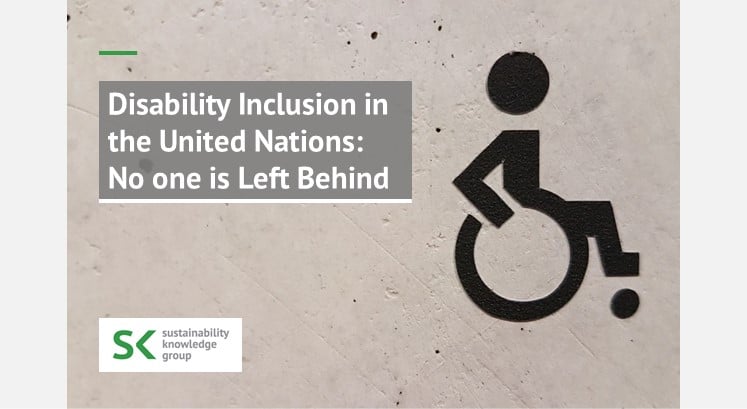15% of the world’s population, or one billion people, are persons with disabilities (PWDs). In June 2019, the United Nations (UN) announced the launch of its “Disability Inclusion Strategy” and work to achieve the SDG 10: reduce inequality. In 2020 and during the 75th Session of the UN General Assembly, the Secretary-General announced the release of the report “Disability inclusion in the United Nations system“.
This report represents the strategy’s early efforts in building a more inclusive UN system for PWDs. The report paves the way for the inclusion of PWDs in the UN system and makes recommendations for the system to do more and combat isolation and marginalization of PWD. It also identifies concrete steps to support member states in implementing the Convention on the Rights of Persons with Disabilities (CRPD), achieving the Sustainable Development Goals (SDGs) and leaving no one behind.
UN Disability Inclusion Strategy
The strategy aims to enhance the meaningful participation of PWDs, and to promote and mainstream their rights in the work of the United Nations. The strategy also works to raise the standards of performance of disability inclusion in the organizations and make an impact on their policies, programs, and operations. This comes through the development of special programs, considering disability-related perspectives, in line with the CRPD.
Work to achieve these goals requires a comprehensive, systematic strategy. The strategy consists of four core areas:
- Leadership, Strategic Planning and Management: Leaders’ commitment is essential to implementing strategy as they are driving change in the organization. Leaders must integrate disability through internal and external communications, review and revise entity policies and strategies, and establish accountability mechanisms.
- Inclusiveness: This requires close consultation with PWDs and ensuring accessibility. Actively involve PWDs in all work of the organization.
- Programming: Where disability is integrated into all program and project cycles to accelerate progress. Implement a minimum level of disability-inclusive programmes and projects through the practical field and headquarters.
- Organizational Culture: Developing recruitment policies and strategies to attract PWDs. Work to build their capabilities, employ and promote them in the UN workforce, raise their level of satisfaction.
COVID-19 response and recovery efforts
This strategy enabled the UN system to take decisions and actions more quickly regarding the inclusion of PWDs in response and recovery efforts to COVID-19. In Policy Brief: A Disability-Inclusive Response to COVID-19, key actions and recommendations are identified to make the response and recovery inclusive for PWDs, leaving no one behind.
The policy brief was developed in cooperation with several entities, with the Special Rapporteur on the rights of PWDs and in consultation with the International Disability Alliance. It was launched in easy-to-access formats, including international signal interpretation and ePub.
The policy brief highlights the impact of COVID-19 on PWDs and identifies key actions and recommendations to make the response and recovery inclusive for PWDs. The brief identifies four overarching areas of action that are applicable to all:
- Ensure mainstreaming of disability in all COVID-19 response and recovery together with targeted actions
- Ensure accessibility of information, facilities, services and programmes in the COVID-19 response and recovery
- Ensure meaningful consultation with and active participation of PWDs and their representative organizations in all stages of the COVID-19 response and recovery
- Establish accountability mechanisms to ensure disability inclusion in the COVID-19 response
Moving Disability Inclusion Strategy forward
The Disability Inclusion strategy provides a concrete framework for sustainable transformation. The strategy aims to make transformative and lasting change for PWDs. This is achieved through their development, empowerment, and capacity building, in addition to developing plans that work to integrate effectively individuals into communities and increase societal awareness about the inclusion and rights of PWDs.
The coordinated implementation of strategy across the organization is facilitated by:
- Mobilizing and maintaining the commitment of the entities leadership
- Establishing a robust coordination mechanism across entities
- Providing technical assistance to entities and the field
- Participating in communication and awareness-raising to raise awareness of the strategy (internally and externally)
The strategy calls for strong leadership within entities to drive its implementation in a meaningful and sustainable manner. The success of the strategy depends on a greater commitment by UN entities to the inclusion of PWDs and to achieving tangible benefits. The commitment to disability inclusion can be achieved by ensuring greater coherence and alignment between the implementation of the strategy and the 2030 Agenda across the UN system.
Photo by marianne bos on Unsplash

